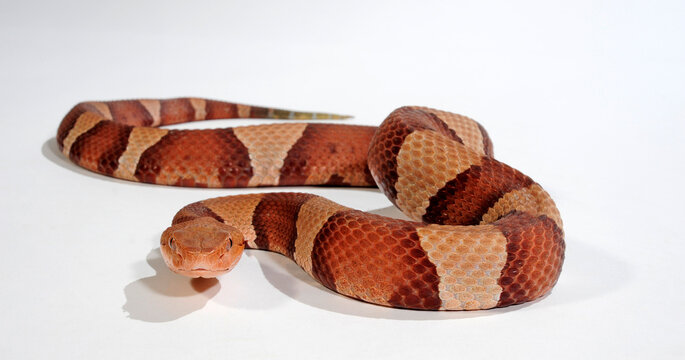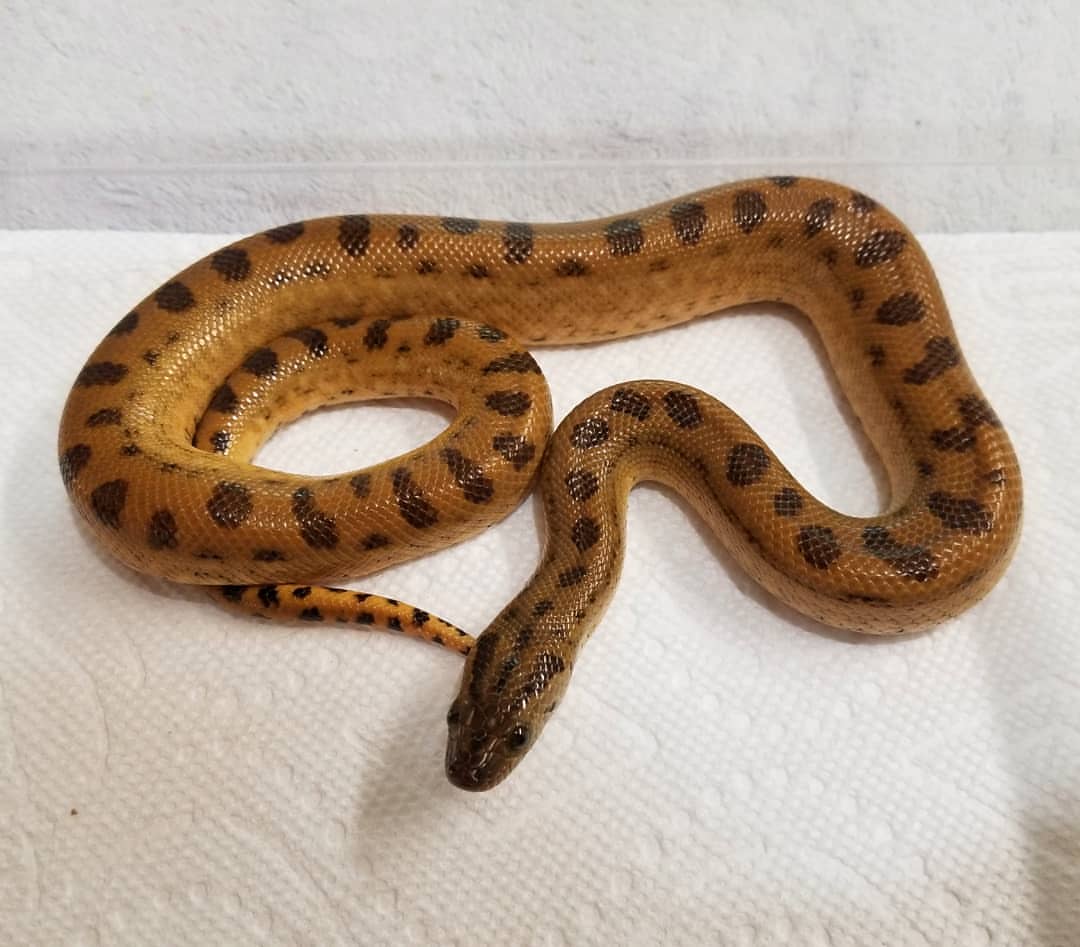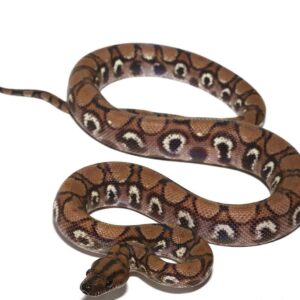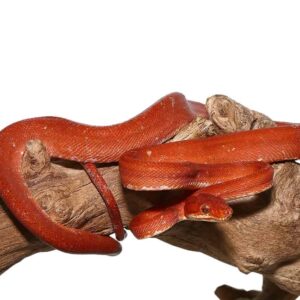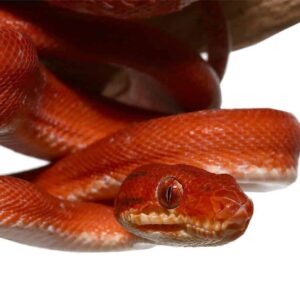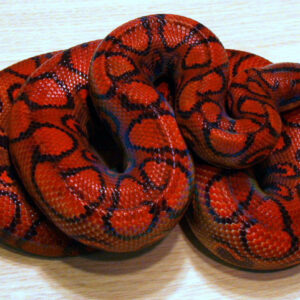High Orange Trans-Pecos Copperhead For Sale
$1,199.99
WE HAVE A PAIR OF HIGH ORANGE TRANS-PECOS COPPERHEAD SNAKES FOR SALE. HERE ARE SOME HIGHLIGHTS:
- Agkistrodon contortrix pictigaster
- Captive Born
- Approximately 20 – 30 Inches In Length
- Adults Can Grow Up To 20 – 36 Inches
- Nocturnal Hunters Feeding On Small Rats Weekly
- *These Are Venomous. Please Know Your State Laws Before Inquiring As Some States Require Venomous Permits*
FUN FACTS!
- AVAILABLE IN THREE VARIANTS: Southern, Broad Banded, And Trans-pecos Copperhead Snake
- This Snake Has Many Habitats That Differ They Mostly Favor Forests, Mixed Woodlands And Low Lying Swampy Regions And Areas With Hiding Places Such As Fallen Trees Rocks Or Rotting Wood
- Females Will Bear Up 1-14 Live Young At A Time
- Originating Out Of Northern And Central America Ranging The Midwest Over To The Eastern Coast Of The United States And Down To Parts Of Mexico Such As Chihuahua And Coahuila
- Gorgeous Snakes With Copper Colors In Wide Saddles And Spots Along Its Sides That Trails It From Head To Tail
- Venomous Reptile That Are Pit Vipers Using Heat Pits Just Underneath Its Eyes
Description
The High Orange Trans-Pecos Copperhead, scientifically known as Agkistrodon contortrix pictigaster, is a captivating subspecies of the copperhead snake. This particular subspecies is also referred to by its common names, including the Trans-Pecos Copperhead or simply the Trans-Pecos. What sets the High Orange Trans-Pecos Copperhead apart from other copperheads is its distinctive, vibrant orange coloration, which makes it a unique and visually striking member of the pit viper family.
Belonging to the Viperidae family, this subspecies showcases a patterning that features broad, hourglass-shaped bands across its body. The high orange hue, which can range from light to deep orange, is particularly noticeable and can serve as a distinguishing feature when identifying this snake in the wild. This coloration not only contributes to its aesthetic appeal but also plays a role in its camouflage within its natural habitat.
The habitat and distribution of the High Orange Trans-Pecos Copperhead are primarily centered in the Trans-Pecos region of Texas, extending into parts of northern Mexico. This region’s unique geographical and climatic conditions create an ideal environment for this snake. It favors rocky outcrops, arid landscapes, and desert scrub habitats where it can effectively blend into its surroundings and find ample prey.
Understanding the High Orange Trans-Pecos Copperhead’s habitat is crucial for conservation efforts and for those who study herpetology. Its distribution within isolated and specific regions makes it a subject of interest for researchers and enthusiasts alike. By exploring its scientific classification, physical characteristics, and natural habitat, we gain a comprehensive overview of why this particular copperhead subspecies is so extraordinary.
Habitat and Distribution
The High Orange Trans-Pecos Copperhead is predominantly found in the Trans-Pecos region of Texas, a unique and distinct area known for its arid and rocky terrain. This region, characterized by its rugged landscapes and semi-desert conditions, provides an ideal habitat for this particular subspecies of copperhead. The snake’s range primarily extends through the southwestern United States, but it is most commonly associated with the specific environmental conditions present in the Trans-Pecos area.
Within this geographic range, the High Orange Trans-Pecos Copperhead thrives in habitats that include rocky outcrops, arroyos, and desert canyons. These habitats are typically composed of sparse vegetation, which includes brush, cacti, and various types of desert flora that provide both cover and hunting grounds for the snake. The arid climate, with its hot temperatures and limited water sources, influences the copperhead’s behavior, making it more active during cooler parts of the day such as dawn and dusk. This crepuscular activity pattern helps the snake avoid the extreme heat of midday while optimizing its hunting efficiency.
The rocky and uneven terrain not only offers camouflage but also provides numerous hiding spots and ambush points, essential for the copperhead’s survival and predation strategies. The snake’s coloration, a high orange hue, allows it to blend seamlessly with the rocky and sandy environment, aiding in both predator avoidance and prey capture. The availability of small mammals, lizards, and insects in these regions serves as a crucial food source, supporting the copperhead’s dietary needs.
Adaptations to this specific environment have influenced the copperhead’s physiological and behavioral traits, ensuring its survival in the challenging conditions of the Trans-Pecos region. Understanding the habitat and distribution of the High Orange Trans-Pecos Copperhead is essential for conservation efforts and for mitigating human-snake interactions in these areas.
Physical Characteristics
The High Orange Trans-Pecos Copperhead, a visually striking subspecies, is well-known for its distinctive physical traits that set it apart from other copperheads and snakes in general. Typically, this snake grows to an average length of 20 to 30 inches, with some individuals reaching up to 36 inches. Their weight generally ranges from 5 to 10 ounces, making them moderately sized compared to other venomous snakes.
One of the most remarkable features of the High Orange Trans-Pecos Copperhead is its vivid coloration. As the name suggests, these snakes exhibit a high concentration of orange hues in their scales. This bright orange coloration is interspersed with darker, hourglass-shaped crossbands that run along their back. These bands are a distinguishing characteristic, as they are more pronounced and vibrant compared to other copperhead subspecies, which typically display more subdued tones.
The head of the High Orange Trans-Pecos Copperhead is another distinctive feature. It is broad and triangular, with a clear separation from the neck, which is a common trait among pit vipers. The eyes are equipped with vertical pupils, enhancing their nocturnal hunting capabilities. The coppery-orange tint of the head and neck region further accentuates their unique appearance.
The scales of this snake are keeled, providing them with a slightly rough texture. This physical trait, combined with their coloration, aids in camouflage, allowing them to blend seamlessly into their natural habitat of rocky outcrops and arid landscapes. Additionally, their belly is typically lighter in color, ranging from cream to pale pink, with occasional dark spots.
Overall, the High Orange Trans-Pecos Copperhead’s distinctive coloration, size, and scale texture make it easily identifiable. These physical characteristics not only differentiate it from other copperhead subspecies but also play a crucial role in its survival and adaptation to its environment.
Behavior and Temperament
The High Orange Trans-Pecos Copperhead exhibits distinctive behavior and temperament that are crucial for understanding its interaction with the environment. Primarily nocturnal, this species becomes more active during the cooler hours of dusk and nighttime, especially in the warmer months. This nocturnal behavior aids in avoiding the extreme daytime temperatures of its native habitat, allowing the snake to hunt and forage under the cover of darkness.
When it comes to its temperament, the High Orange Trans-Pecos Copperhead is generally non-aggressive but can exhibit defensive behaviors when threatened. These snakes are more likely to rely on their camouflage to avoid detection, blending seamlessly into their surroundings. If a threat persists, they may exhibit a characteristic defensive display, including tail vibration, body inflation, and releasing a musky odor to deter predators. Striking is usually a last resort, reserved for situations where escape or intimidation fails.
Regarding social behaviors, the High Orange Trans-Pecos Copperhead is typically solitary, except during the mating season or when hibernating in communal dens. Their solitary nature means encounters between individuals outside these periods are rare. These snakes have a specific home range and exhibit site fidelity, often returning to the same hibernation sites year after year.
Understanding these behavioral patterns is essential for anyone interested in the High Orange Trans-Pecos Copperhead. It highlights the importance of respecting their space and recognizing their natural tendencies. Observing these snakes from a safe distance and minimizing disturbances can contribute significantly to their conservation and our appreciation of their role in the ecosystems.
Diet and Hunting Techniques
The High Orange Trans-Pecos Copperhead is a fascinating predator with a diverse diet that primarily includes small mammals, birds, and insects. This species is an opportunistic feeder, adapting its diet based on the availability of prey in its environment. Small rodents such as mice and voles form a significant portion of its diet, especially during the warmer months when these mammals are abundant. Birds, particularly ground-dwelling species, are also targeted, often during the nesting season. Additionally, a variety of insects, including beetles and grasshoppers, complement its nutritional intake, making this snake a versatile hunter.
One of the key hunting techniques employed by the High Orange Trans-Pecos Copperhead is its exceptional use of camouflage. The snake’s distinctive coloration allows it to blend seamlessly into its surroundings, whether it is leaf litter, rocky terrain, or dense foliage. This natural camouflage is crucial for its ambush predation strategy, where the snake remains motionless and waits for unsuspecting prey to come within striking distance. When the opportunity arises, it strikes with remarkable speed and precision, delivering a venomous bite that immobilizes its prey.
Seasonal variations significantly influence the diet of the High Orange Trans-Pecos Copperhead. During the spring and summer months, when small mammals and insects are plentiful, the snake’s diet is more varied and abundant. In contrast, the colder months see a shift towards a more limited diet, often focusing on what is readily available. The snake’s ability to adapt its hunting techniques and dietary preferences according to seasonal changes ensures its survival in the diverse habitats it occupies.
Understanding the diet and hunting techniques of the High Orange Trans-Pecos Copperhead provides valuable insights into its behavior and ecological role. This adaptability in feeding habits underscores the snake’s resilience and its critical place within the ecosystem.
Reproduction and Lifespan
The High Orange Trans-Pecos Copperhead exhibits distinctive reproductive habits that are crucial for understanding its life cycle. Mating typically takes place in the spring, a period that aligns with optimal environmental conditions for the survival of their offspring. During this season, males engage in combat rituals to secure mating rights, a behavior observed in many snake species. The gestation period for the High Orange Trans-Pecos Copperhead spans approximately three to four months, culminating in the birth of live young, as this species is ovoviviparous. Each female can produce a brood of 3 to 10 neonates, although the average number tends to be around 5 to 7. These young copperheads are born fully independent and equipped with venom, which is essential for their survival from the onset.
From birth, the High Orange Trans-Pecos Copperhead undergoes several growth phases, molting its skin multiple times as it matures into adulthood. Juveniles have a distinct coloration that becomes more pronounced and vibrant as they age, a characteristic feature of the High Orange variant. Their diet primarily consists of small rodents, frogs, and insects, which they hunt using their heat-sensing pits and keen sense of smell. The transition from juvenile to adult is marked by sexual maturity, which typically occurs around two to three years of age.
The lifespan of the High Orange Trans-Pecos Copperhead varies significantly between wild and captive environments. In the wild, these copperheads face numerous threats, including predation, habitat destruction, and human interference, which can result in a lifespan of around 10 to 15 years. In contrast, individuals kept in captivity often benefit from a controlled environment, regular feeding, and medical care, enabling them to live up to 20 years or more. Understanding these aspects of their biology is essential for conservation efforts and for those interested in maintaining these copperheads in captivity.
Conservation Status and Threats
The High Orange Trans-Pecos Copperhead (Agkistrodon contortrix pictigaster), a subspecies noted for its distinctive coloration, currently faces numerous challenges that impact its conservation status. As of the most recent assessments, it is not listed as endangered or critically threatened; however, its population is experiencing pressures that could alter its status if not addressed promptly.
One of the primary threats to the High Orange Trans-Pecos Copperhead is habitat destruction. The expansion of urban areas, agricultural development, and infrastructure projects have led to significant loss of the natural habitats that this subspecies relies on. Fragmented habitats not only reduce the available living space but also isolate populations, making it difficult for them to find mates and maintain genetic diversity.
Climate change is another burgeoning threat. Changes in temperature and precipitation patterns can disrupt the delicate balance of the ecosystems where these copperheads thrive. Altered climates can affect their prey availability, hibernation cycles, and reproductive success, leading to population declines over time.
Human activity, particularly direct encounters with humans, poses additional risks. High Orange Trans-Pecos Copperheads are often misunderstood and feared, leading to unnecessary killings. Furthermore, illegal collection for the pet trade also contributes to the decline in their numbers.
In response to these threats, several conservation efforts have been initiated. Organizations such as the Texas Parks and Wildlife Department and various herpetological societies are actively involved in monitoring populations and promoting habitat preservation. Protective measures include the establishment of reserves and conservation easements that safeguard critical habitats from development. Public education campaigns aim to raise awareness about the importance of these snakes in their ecosystems and to reduce unwarranted fear and persecution.
Continued research and collaboration among conservationists, scientists, and local communities are essential to ensure the long-term survival of the High Orange Trans-Pecos Copperhead. By addressing the primary threats and implementing effective conservation strategies, we can help protect this unique subspecies for future generations.
Interacting with the High Orange Trans-Pecos Copperhead
Encountering a High Orange Trans-Pecos Copperhead in the wild necessitates a cautious and respectful approach. This strikingly beautiful yet venomous snake commands attention and should be appreciated from a safe distance. Understanding how to recognize its presence and avoid negative interactions is crucial for both your safety and the preservation of this species.
Firstly, recognizing the High Orange Trans-Pecos Copperhead’s distinct features can help in identifying the snake. It exhibits a vibrant orange hue with crossbands that vary in color from copper to dark brown. These patterns serve as camouflage in its natural rocky and arid habitat, making it essential to remain vigilant when navigating these areas. Pay close attention to any rustling sounds in leaf litter or underbrush, as these could indicate the snake’s presence.
When hiking or exploring areas known to be inhabited by the High Orange Trans-Pecos Copperhead, it is advisable to wear sturdy boots and long pants. Staying on well-trodden paths reduces the likelihood of accidental encounters. Should you spot a copperhead, maintain a distance of at least six feet. The snake is generally non-aggressive and will often retreat if given the opportunity. Avoid any sudden movements or attempts to handle the snake, as this increases the risk of a defensive bite.
In the unfortunate event of a copperhead bite, it is imperative to seek medical attention immediately. Keep the affected limb immobilized and at or below heart level to slow the spread of venom. Avoid applying ice or using a tourniquet, as these measures can exacerbate tissue damage. While waiting for professional assistance, remain as calm and still as possible to prevent the venom from circulating rapidly through your bloodstream.
Above all, respecting wildlife and maintaining a safe distance is paramount. The High Orange Trans-Pecos Copperhead plays a vital role in its ecosystem by controlling rodent populations. By observing these guidelines, you can ensure a safe and enriching experience in the natural habitats where this remarkable snake resides.
